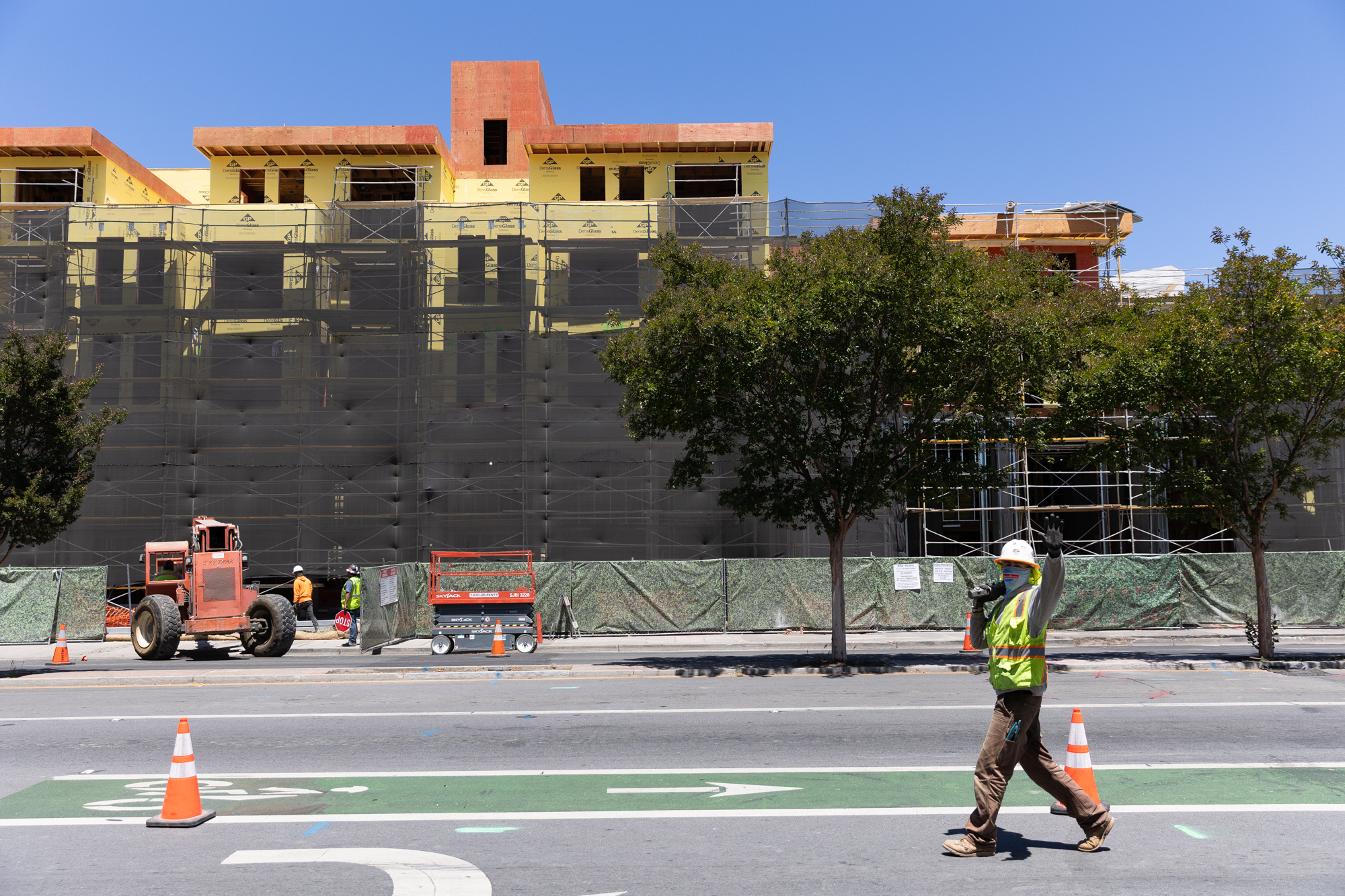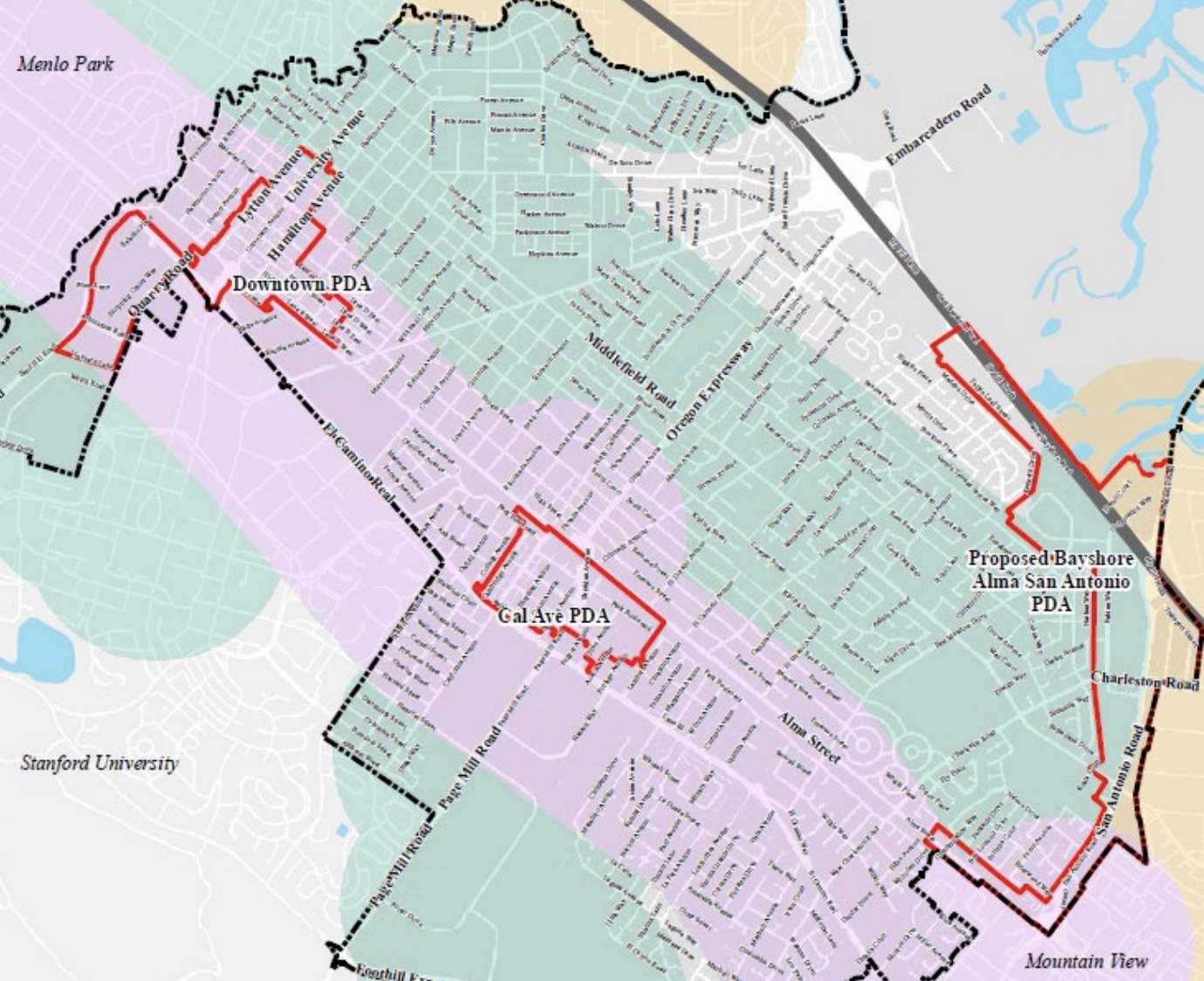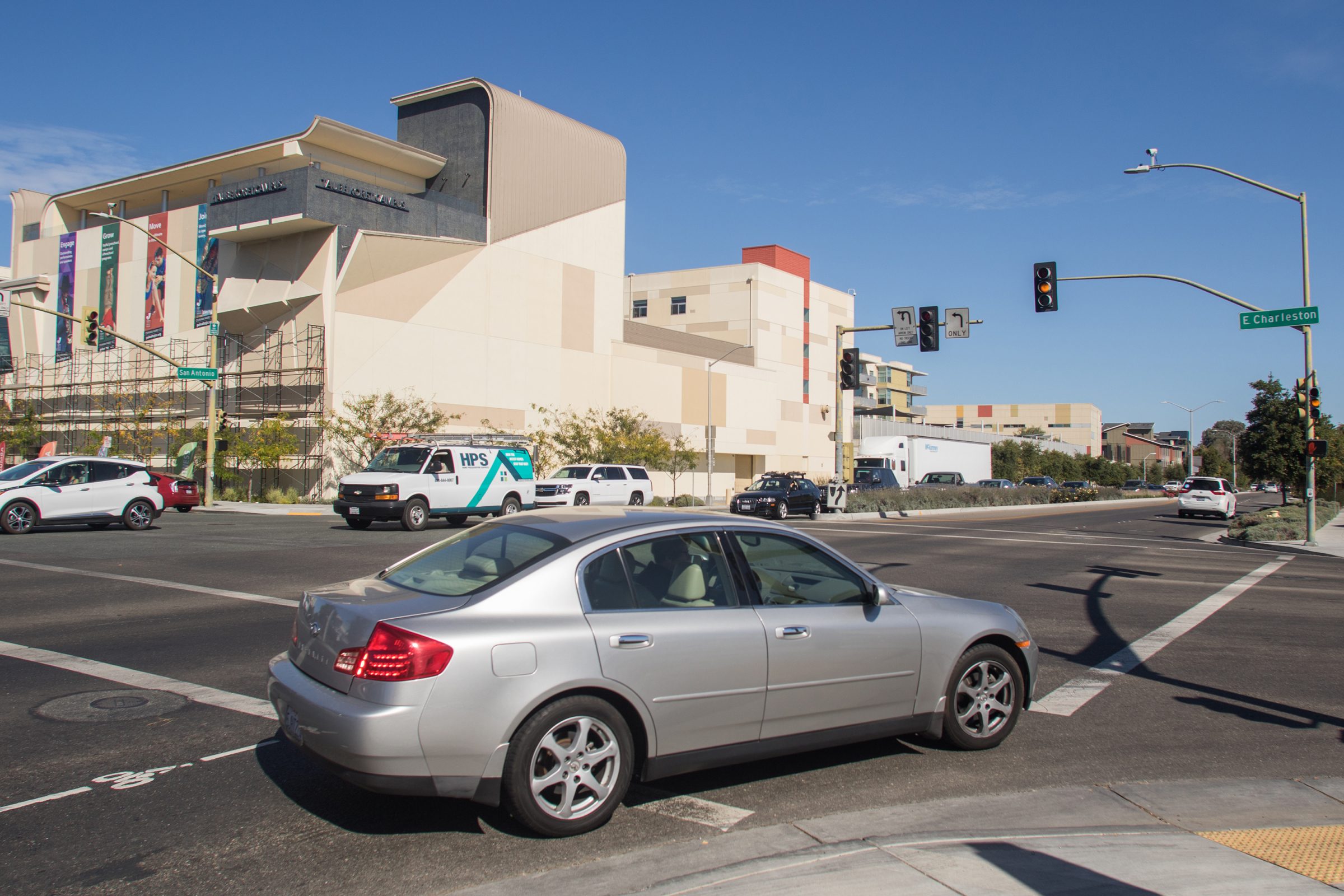Palo Alto doesn't have to look far to see the growth potential of San Antonio Road.
The busy artery, which divides the city from Mountain View, also illustrates the cities' different approaches to development. In Mountain View, the City Council approved four years ago a precise plan that envisions San Antonio as the linchpin of a vibrant, retail-heavy and pedestrian friendly neighborhood stretching between El Camino Real and the Caltrain corridor.
About half of the plan's 123-acre area is within the San Antonio Center shopping area, which has been redeveloped in phases over the past decade and which includes housing, offices, a hotel stores and a cinema. The city is now reviewing the third phase of the development, which includes a seven-story office building with retail on the ground floor .
Palo Alto, meanwhile, is envisioning a different kind of growth on its side of San Antonio. The city's recently adopted Housing Element calls for adding about 2,000 dwellings on and near San Antonio Road between 2023 and 2031, which represents close to a third of the city's total housing target of 6,086 residences. If things go as planned, most of these would go up on sites currently zoned for industrial or commercial uses.
But unlike Mountain View, Palo Alto hasn't really sketched out what its new San Antonio community will look like. Even though council members and planning commissioners often talk about the need to add amenities to support San Antonio's future residents, housing has dominated the conversation -- much to the exclusion of everything else.
Offices are largely seen as a nonstarter, retail is an afterthought and transportation improvements, while widely acknowledged as vital, are both unfunded and undefined.
The Palo Alto council took a step toward changing that on Sept. 18, when council members agreed to designate a segment of San Antonio and surrounding neighborhoods as a "priority development area," a label that will allow the city to apply for planning grants from the Metropolitan Transportation Commission and the Association of Bay Area Governments. Prior to the Monday action, downtown and California Avenue were the only two areas of Palo Alto to hold this designation.
Unlike Mountain View, Palo Alto is focusing its planning efforts on the portion of San Antonio east of the Caltrain tracks. The newly created priority development area is shaped like a crescent that stretches south along Bayshore Road, just south of Colorado Avenue, cuts southwest to encompass San Antonio Road and surrounding streets and then juts north up Alma Street before coming to a halt near Adobe Creek.
Its curve extends southeast to the city limit and includes parcels on East Meadow Circle, Fabian Way and Alma Street.
According to planning staff, the designation makes the city eligible for up to $1.2 million in funding to create an area plan for these streets, up to $600,000 for a plan amendment and up to $200,000 for implementation or technical assistance.
The money, could be used to commission a corridor study that explores transportation improvements, conduct further analysis of Housing Element opportunity sites, pursue a redesign of the San Antonio Road and U.S. Highway 101 cloverleaf, and a study the housing potential at congregations along Alma Street, Planning Director Jonathan Lait said during the Monday, Sept. 18, presentation.
"While we wouldn't anticipate a qualifying project to occupy all portions of the boundary, we would expect that there might be certain components along this corridor that is interconnected and related that could enable us to receive funding for certain projects going forward," Lait said.
While the money is not guaranteed, Palo Alto's recent experiences give it reason to feel optimistic. The city's new North Ventura Coordinated Area Plan, which focuses on a section of the Ventura neighborhood within the broader California Avenue "priority development area" benefited from a $638,000 grant.
The city has also received an $800,000 grant for a downtown housing plan, though that effort that has yet to take off.
With the deadline for declaring priority development areas looming, Lait said planning staff had informed the MTC earlier this month about the designation of San Antonio. On Monday, he requested that the council affirm that decision. The council did so by a 6-1 vote, with Mayor Lydia Kou dissenting.
While most council members saw the action as a prudent step toward obtaining regional resources, the newly proposed designation caught some people off guard. Penny Ellson, a long-time bike advocate, said she was surprised by the lack of outreach by the city to the neighborhoods in the new planning area.
This, Ellson said, stands in sharp contrast from past planning exercises in south Palo Alto, including the recent effort to rebuild the Charleston-Arastradero corridor in which she had participated.
"I think it's going to matter a lot what the project is," Ellson said. "Is there going to be a school crossing for kids who live on the south side of San Antonio Road? Is it going to be something more automobile-oriented? How is it going to connect people to the train station? Is there going to be transit? And if there is going to be transit, where is it going?"
"I have a lot of questions that are unanswered and we're talking about something that is transformative," Ellson said.
Kou similarly lamented the lack of outreach to the public before voting against the designation. She noted that the priority development area proposed by staff goes well beyond San Antonio and includes various residential neighborhoods.
"I really think as a council we should be considering, when these things come to us, that there is a time period for letting the public know about it so we're discussing it in a way that is inclusive of the public as well," Kou said.
Others, however, saw this as a reasonable step toward transformation of San Antonio, which the city is now in the process of rezoning to accommodate taller and denser residential buildings.
The city's adopted Housing Element calls for a program that would allow areas along San Antonio that are zoned for "general manufacturing" (GM) and "research, office and light manufacturing" (ROLM) to accommodate up to 81.25 dwellings per acre, which is twice as many as would currently be allowed in the city's densest multifamily zoning district.
Council member Julie Lythcott-Haims likened the designation to a "procedural gate that we have to pass through that makes it possible that in the future we'll be eligible for bigger grant money."
"And community input is going to be essential on what we're going to build and how we're going to build it, from bikes to pedestrians to housing to parks and all of that."
Vice Mayor Greer Stone and Council member Ed Lauing both concurred and suggested that there is really no downside to applying. While Stone and other council members said he wishes there was more transparency in how this item is publicized (including clearer wording on the agenda), he made the case for moving ahead with creating the new priority development area.
"We're on a strict deadline," Stone said. "I'd hate to see us miss these funding opportunities, especially the meaningful funding for affordable housing in these areas that we've already identified as areas of future growth in the city."





Comments
Registered user
College Terrace
on Sep 19, 2023 at 10:49 am
Registered user
on Sep 19, 2023 at 10:49 am
That’s right. Re-zone to commercial 15 acre RM30 all residential parcel in the center and near everything needed for a resident. Then within hours, turn right around and re-zone all commercial multiple properties (not owned by the city either) to residential — in a flood plane, on the 101, a transit and city, hospital service. . It’s a silt & sand wash out . I wonder how this mass development will be included in such ordinances as Leaf Blowers, noise, police services ... this is so far off the Richter scale, it’s fiction. It’s a tag and bag zoning for expediency only.
Registered user
Adobe-Meadow
on Sep 19, 2023 at 10:50 am
Registered user
on Sep 19, 2023 at 10:50 am
Affordable Housing for whom? If we envision housing for our wait staff, housekeepers and gardeners, as I sometimes hear in arguments, will these homes be affordable for them? I hear nothing about schools and daycare being discussed. Safeway in Midtown has been denied expansion for decades…Have you tried making an appointment with a Healthcare Provider lately? It can take months. Businesses are charged extra taxes for the fun of it, utilities are raised for the convenience of it, crime is excused and local jobs are disappearing. But, everyone will be accommodated in a house they cannot afford and take the train to an imaginary job somewhere.
Registered user
Another Palo Alto neighborhood
on Sep 19, 2023 at 5:19 pm
Registered user
on Sep 19, 2023 at 5:19 pm
We are losing useful businesses and retail all over town. We are losing recreational activities.
Where will all these extra residents go for coffee, for haircuts, for a quick sandwich lunch, for shoes, for childcare, for school? Where will they go to play in a park, to go bowling, to play basketball, to have fun on a dark evening in winter or a wet Saturday afternoon?
Somewhere along the line we have to start valuing quality of life for our residents. People want to do more than hibernate in their rabbit hutch homes or hike the Baylands
Registered user
Midtown
on Sep 19, 2023 at 6:58 pm
Registered user
on Sep 19, 2023 at 6:58 pm
@Bystander: Amen!
Registered user
Embarcadero Oaks/Leland
on Sep 19, 2023 at 8:46 pm
Registered user
on Sep 19, 2023 at 8:46 pm
Lure growth & grants??? How about filling some of the many vacancies first??
(I know, the developers and their DODO politicians wouldn't go for that because it's too sensible and the consultants would have nothing to do, no mapping presentations and 3-D models...._
Registered user
Crescent Park
on Sep 26, 2023 at 10:11 am
Registered user
on Sep 26, 2023 at 10:11 am
Let's keep an open mind. As the article says, Mountain View has put a lot stuff along San Antonio. This doesn't need to be oriented to Caltrain when its so close to the very large campuses of Google, LinkedIn and Intuit. Their private bus fleets will proivde transportation.
We should start to view this as more similiar to Mountain View's North Bayshore plan than anything else. 1/3 of our RHNA sites, adjancent to the large tech companies that have caused this mess makes sense. Let's not treat it like a project near El Camino or in the midst of a large residential neighborhood. This is perhaps the last large area of Palo Alto ripe for redevelopment. Let's support the process and make it good, understanding we are being forced to do this by the State of California.